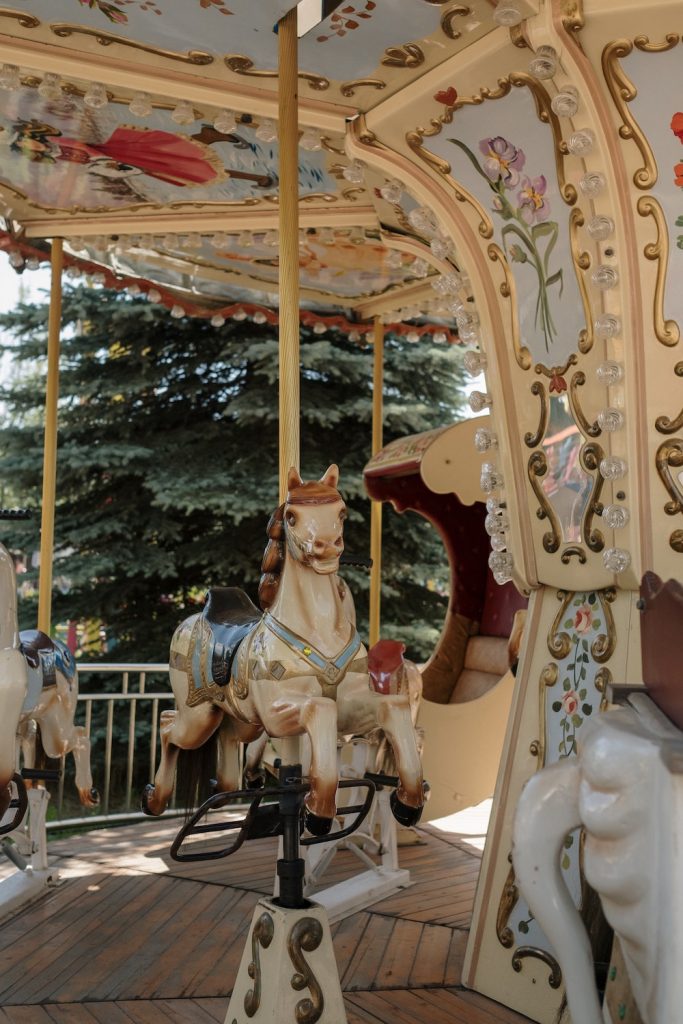In my story, “The Merry-Go-Round,” four-year-old Ginny, seated on a fancy turquoise-and-gold painted pony on her first merry-go-round ride, is feeling jittery about finding her way back. Her grandpa, Mayor Marty, declares, ‘”What goes around, comes around,” as he accompanies her on the merry-go-round, also known as a carousel. Let’s take a look at the iconic carousel, a ride that has, for generations, faithfully returned its happy riders right back to where they started from.
Jousting traditions from the Middle East and Europe were forerunners of the modern-day carousel. Knights would gallop in a circle as they tossed balls to one another, sharpening their skills as they played. The word carousel comes from the Italian word, carosella, which means “little battle,” referring to a combat preparation game originating in Turkey and Arabia in the twelfth century.
By the seventeenth century, the game had evolved into a cavalry spectacle, popular in Italy and France. The balls had been dispensed with; instead, the riders had to spear and rip off small rings that hung from overhead poles. The game gained popularity with the general populations; the cavalry games inspired rides using wooden horses, which began to spring up at fairgrounds across Europe.

By the early eighteenth century, an increasing number of carousels could be found all over Europe, as well as in England. Families would craft the wooden horses (and other animals) during the winter season, and then go touring with their creations later, as the weather warmed. These early carousels did not yet have platforms; the wooden horses would hang from chains and fly out from the centrifugal force of the spinning mechanism. The rides were powered by real animals walking in a circle or even by people pulling ropes.
By the middle of the nineteenth century, the platform carousel was developed. The horses (or other animals) and chariots were attached to a circular floor suspended from a center pole, from which they would rotate. The first steam-powered mechanical carousel appeared in England in 1861. Soon after, English engineer Frederick Savage became the top innovator of the carousel (known in England as the roundabout). His innovations were purchased for fairgrounds the world over. By around 1900, electric motors began to replace steam-powered merry-go-rounds.
During the heyday of the merry-go-round, from about 1870 to 1930, between five and six thousand carousels could be found throughout the United States. They were fixtures at just about every fairground and amusement venue. Pleasure seekers everywhere looked forward to getting their whirl around the colorful carousels. Today, only about 160 of these historic carousels remain. National Carousel Day is a salute to the summer day in 1871 when William Schneider of Davenport, Iowa, was issued the first American patent for a carousel.
As we gallop ahead in time, over a century later in small-town Iowa, Ginny learns an important lesson. At a crucial time, her painted pony will bring her right back to where her grandpa’s lesson will take on new significance in her life—and in the life of her kind and wise grandfather.
Sources:
Matt Blitz, “Take a Spin on the Most Beautiful, Handcrafted Carousels in the Nation,” in Travel, July 24, 2015
“Carousel,” Wikipedia
 View Ava Lepor's Amazon.com Author Page!
View Ava Lepor's Amazon.com Author Page!